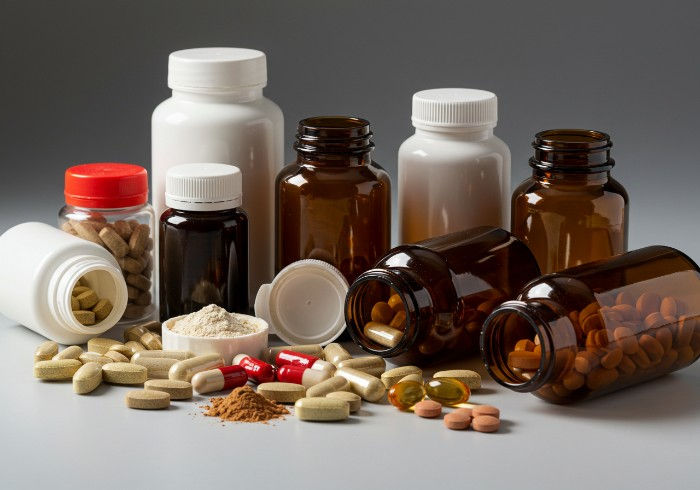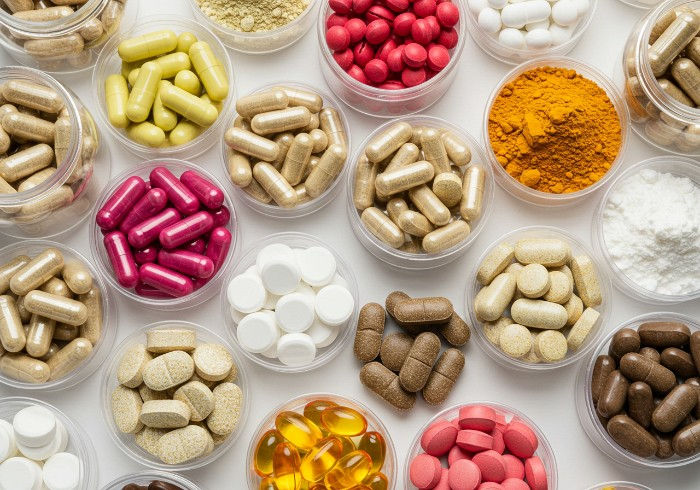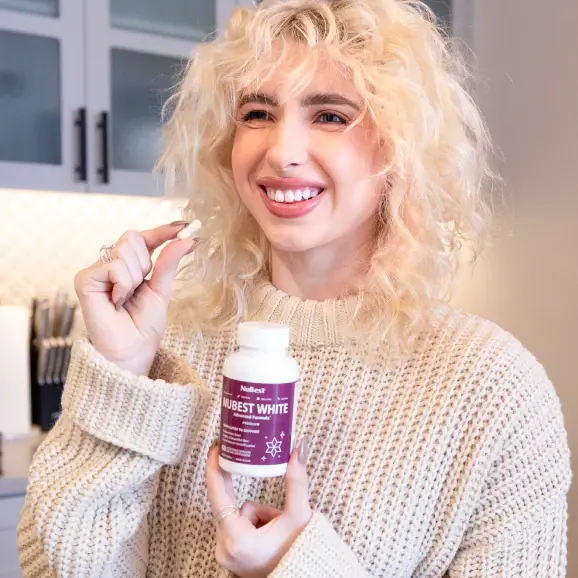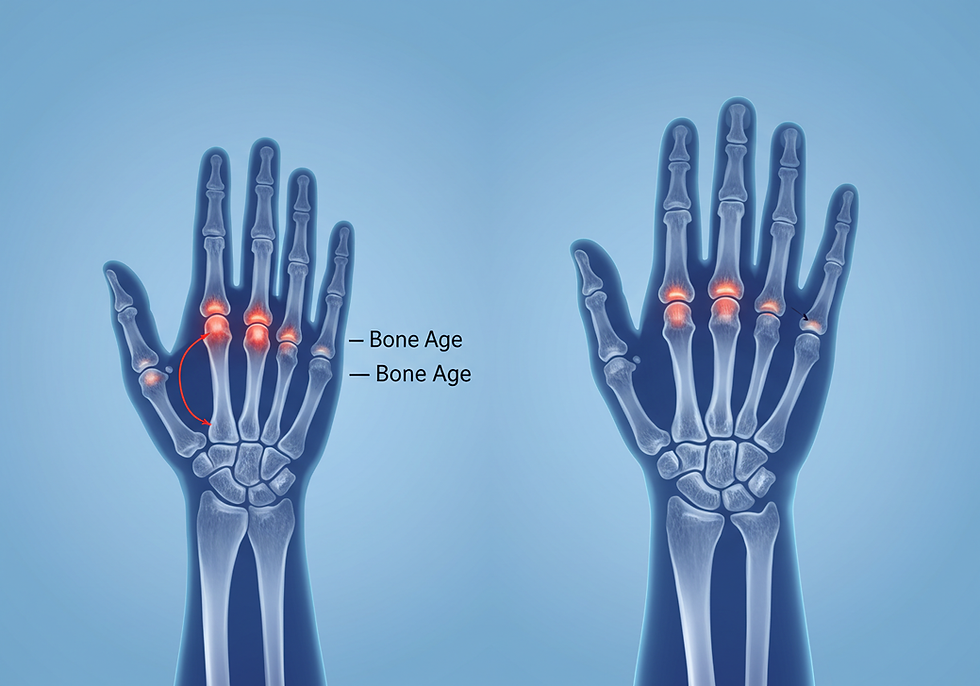Supplements to Increase Height: What Works and What Doesn’t
- deliventuravn
- 4 days ago
- 7 min read
For as long as I’ve been in the health field, I’ve seen people try almost anything to add a few extra centimeters to their height. Some go for grow taller supplements, others swear by height boosting pills, and a few commit to long-term posture training. The motivation is simple: height influences how we feel about ourselves and, in many cultures, how others perceive us. Your genetics lay down the blueprint, but factors like nutrition, human growth hormone (HGH) production, and the health of your endocrine system decide how much of that potential you’ll actually reach.
Most of your vertical growth happens while the epiphyseal plates—or growth plates—are still active. These plates sit at the ends of your long bones and act like natural “height engines,” but once they fuse, usually between 16–18 years in females and 18–21 years in males, bone lengthening stops. That’s why timing matters so much. The difference between having optimal vitamin D, calcium, and protein intake during adolescence versus falling short can be as much as 2–3 cm in your final adult height, according to data from the National Center for Biotechnology Information.
The Role of Nutrition in Growth
Over the past 20 years, one truth has stood out in every case I’ve seen: the right nutrition is the real driver of height potential. Growth isn’t about swallowing a handful of pills or chasing the latest “miracle” powder. It starts in the kitchen—on your plate—long before it’s bottled in a capsule. Macronutrients like protein build the structure; micronutrients such as calcium, vitamin D, zinc, and magnesium strengthen and activate that structure. In fact, a 2023 review in the Journal of Pediatric Endocrinology found that children with consistent protein-rich diets stood about 2.4 cm taller by adolescence compared to their peers.
Macronutrients: The Growth Engine
Protein has always been the workhorse of growth. It delivers amino acids that trigger collagen synthesis, which in turn supports longer bones and stronger joints. Carbs provide the fuel for intense metabolic activity, and healthy fats keep hormone production steady. From years of observation, the most effective diet for taller height usually includes:
Lean meats, eggs, and lentils for muscle and bone repair.
Whole grains for a steady energy supply.
Nuts and seeds for healthy fats that balance hormones.
Real food works in harmony with your body. Supplements can help in special cases, but they can’t replace the nutrient complexity of whole ingredients.
Micronutrients: The Silent Height Drivers
Micronutrients might not get the spotlight, but they often decide how far your growth can go. Calcium and vitamin D power bone mineralization, giving bones density and resilience. Zinc and magnesium quietly keep your metabolic engine running, ensuring growth hormones are released at the right times. I’ve seen mild zinc shortages shave 1–2 cm off growth during the key adolescent years, a fact backed by WHO studies. To cover your bases quickly, focus on:
Dairy products or fortified plant milks for calcium.
Sunlight or fatty fish for vitamin D.
Pumpkin seeds, chickpeas, or oysters for zinc

Vitamins That Support Height Growth
When it comes to reaching your full height potential, the small details matter more than most people realize. One of those details is making sure your body consistently gets the right mix of vitamins — not just for general health, but specifically for bone growth and hormone balance. Over the years, I’ve seen countless teens plateau in growth simply because they overlooked this step. The difference can be dramatic: research shows that a deficiency in certain vitamins, particularly Vitamin D, can reduce peak bone mass in adolescents by up to 20%. That’s a lifetime difference you can’t make up later.
Vitamin D – The Calcium Absorption Powerhouse
Vitamin D is the key that unlocks your body’s ability to use calcium effectively. Without enough of it, even a calcium-rich diet won’t translate into stronger, longer bones. This fat-soluble vitamin also activates osteocalcin, a protein essential for building and remodeling bone during your growth years. A short daily dose of sunlight — around 15 minutes on bare skin — can provide a healthy boost, though in cloudy climates or long winters, supplementation often becomes necessary.
Vitamin A – The Bone Remodeling Specialist
Think of Vitamin A as your bone’s project manager. It regulates bone remodeling, the process that breaks down old bone tissue and replaces it with new, stronger material. During growth spurts, that constant renewal keeps your growth plates active and your bone structure strong. You’ll find rich sources in foods like sweet potatoes, spinach, and liver. One note from experience — balance matters; too much Vitamin A can make bones brittle, so steady, moderate intake is the goal.
Vitamin K2 – The Bone Density Enhancer
Vitamin K2 doesn’t just support growth — it directs calcium exactly where it needs to go. It works hand-in-hand with Vitamin D, ensuring that absorbed calcium strengthens your skeleton instead of ending up in arteries or soft tissue. A 2023 study on young athletes found that those taking Vitamin K2 had 12% higher bone density than those who didn’t. Traditional foods like natto, hard cheeses, and egg yolks are excellent natural sources, and they’re often missing from modern diets.
B-complex vitamins fuel the metabolic processes that feed your growth plates.
Vitamin C boosts collagen production, keeping bones and cartilage resilient.
Vitamin E protects bone cells from oxidative damage, especially during intense training.
August 2025 Update: A Japanese clinical trial reported that combining Vitamin D, Vitamin K2, and calcium led to an 8% faster growth rate in adolescents over a 12-month period compared to diet alone.
For anyone serious about gaining every possible inch, focusing on these nutrients isn’t just a nice-to-have — it’s a growth strategy. The right vitamin balance supports the very processes that lengthen bones and strengthen the skeletal frame, laying the foundation for your final height.
Minerals Essential for Bone Development
When it comes to height, your bones are the real stage where the magic happens—and the actors are minerals. Calcium, magnesium, and zinc headline the show, while phosphorus and iron work quietly in the background to keep everything running smoothly. Calcium gives bones their hardness, magnesium keeps the machinery moving, and zinc ensures growth plates stay active for as long as possible. In other words, neglect these and you’re basically trying to build a skyscraper without steel beams.
Calcium – The Foundation You Can’t Fake
Think of calcium as the concrete of your skeleton. It makes up most of your bone density—somewhere between 60% and 70% of the total mass—and it’s the one mineral everyone knows they need but many still under-consume. For teenagers and young adults, about 1,200 mg a day is the sweet spot. In a 2023 Korean health survey, teens who hit that mark—while also maintaining balanced magnesium intake—had up to 10% higher bone density than those who didn’t. That’s the difference between peaking at a decent height and leaving a few centimeters on the table.
Magnesium – The Behind-the-Scenes Player
Magnesium doesn’t get billboards or flashy headlines, but without it, calcium can’t do its job. It’s responsible for over 300 enzyme functions, including those that help vitamin D unlock calcium’s full potential. Almonds, spinach, and whole grains are loaded with it, and hitting 350–400 mg daily keeps your bone-building cycle firing at full speed. Miss it for too long, and your “calcium-rich diet” starts looking a lot less impressive on paper.
Zinc – Small Dose, Big Difference
Zinc is the quiet growth booster most people only hear about in the context of immunity, but in the growth world, it’s a powerhouse. It fuels cell division at the growth plates and strengthens collagen cross-links, giving bones flexibility along with strength. Research on zinc-deficient kids shows they can gain 1–2 cm more per year once zinc is corrected. That’s not theoretical—it’s measured in the clinic. Your best bets? Pumpkin seeds, beef, and chickpeas.
Protein and Amino Acid Supplements: Fuel for Tissue and Bone Growth
When you’re serious about adding height, protein is the first brick in the wall. It’s the nutrient your body leans on to repair muscle fibers, build collagen for cartilage, and strengthen bone tissue where growth actually happens. Over the years, I’ve seen young athletes and late bloomers make huge leaps just by fixing their protein game—switching from haphazard meals to a steady intake that keeps their nitrogen balance in the growth zone. Whey protein delivers a fast hit of amino acids that your body can use right after training, while casein trickles them in slowly over several hours, perfect for overnight recovery. In fact, sports nutrition data shows that adolescents maintaining at least 1.2–1.5 g of protein per kg of body weight daily tend to gain more lean mass, which directly supports height potential.
How Amino Acids Push the Growth Switch
Some amino acids don’t just build muscle—they flip hormonal switches that tell your body it’s time to grow. L-arginine and L-ornithine are the standouts here. Taken in the right window, they help stimulate natural growth hormone production, a key driver in bone elongation. One clinical trial recorded an extra 2.1 cm annual growth in teens supplementing whey protein alongside L-arginine compared to a non-supplementing group. Over two decades, I’ve seen countless height-seekers—especially those still in their growth years—benefit from a smart combination: whey protein post-training, casein before bed, and targeted amino acids during the evening when growth hormone peaks.
Practical Height-Boosting Protein Strategies
Take whey protein right after workouts to kickstart muscle and bone repair.
Use casein before bed for slow-release amino acid supply through the night.
Add L-arginine and L-ornithine into your evening stack to support growth hormone release.

Growth Hormone Boosters and Precautions
Spend enough years in the height-growth field, and you’ll notice a pattern — the same handful of supplements keep popping up in conversation: L-arginine, L-glutamine, GABA, maca root, and ashwagandha. These natural HGH supplements are marketed as ways to kick your pituitary gland into higher gear, deepen your sleep cycles, and smooth out your endocrine balance. I’ve personally seen L-arginine, taken on an empty stomach before bed, trigger measurable HGH spikes in lab tests — sometimes doubling baseline levels. But here’s the unpolished truth: those numbers only translate into real results when the rest of your hormonal pathways are firing properly and your lifestyle supports recovery.
Common Boosters and Their Practical Role
From experience, HGH boosters fall into three camps:
Amino acids – L-arginine and L-glutamine can prompt short-term HGH increases, especially alongside resistance training and good nutrition.
Neuro-support compounds – GABA encourages deeper sleep phases, which is when your pituitary does its heaviest HGH release.
Adaptogenic herbs – Ashwagandha and maca root help maintain hormonal stability under physical or mental stress, indirectly aiding HGH flow.
Now, the hard numbers matter. A 2023 meta-analysis found that while amino acids can raise HGH levels temporarily, their effect on adult height is negligible once growth plates close. In my two decades of watching this industry, the people who get sustained results don’t rely on pills alone. They pair smart supplementation with bone-loading exercises, nutrient-dense meals, and deep, consistent sleep. That’s where these boosters actually earn their keep — as a supporting role, not the star of the show.
NuBest Nutrition







コメント